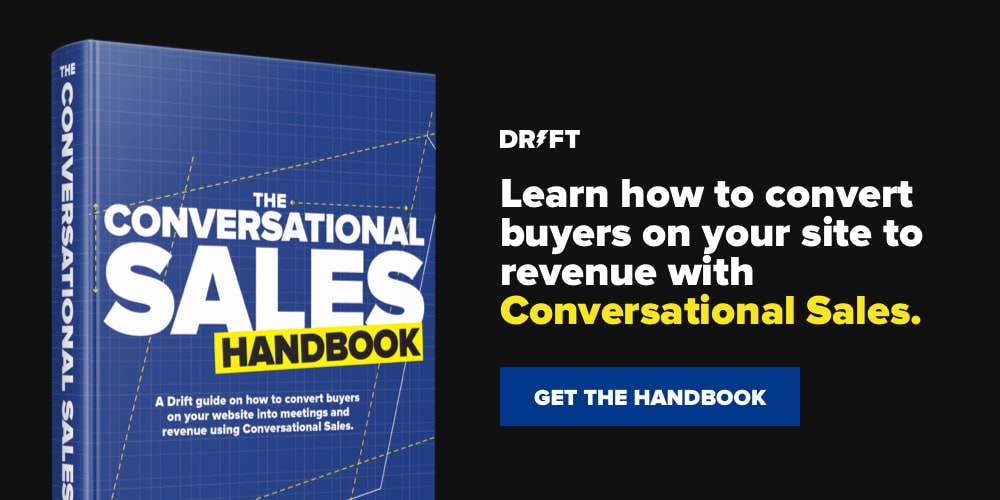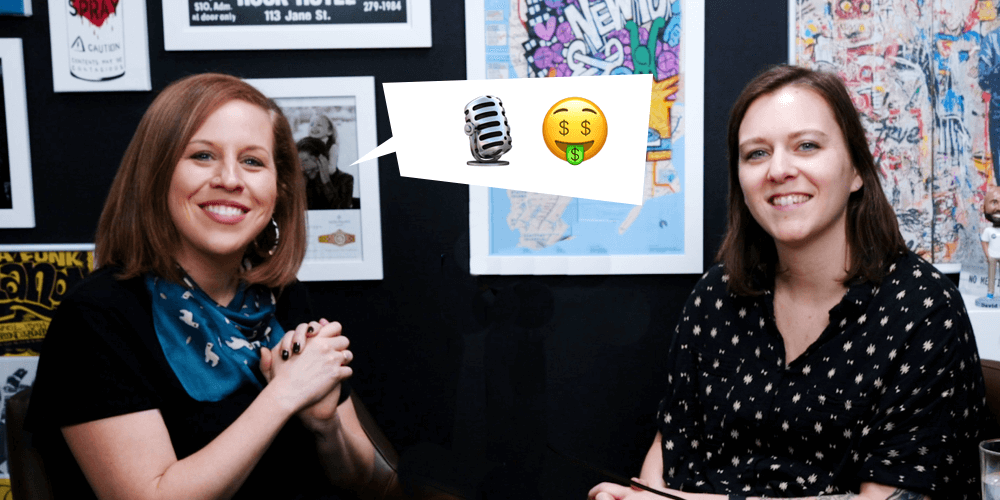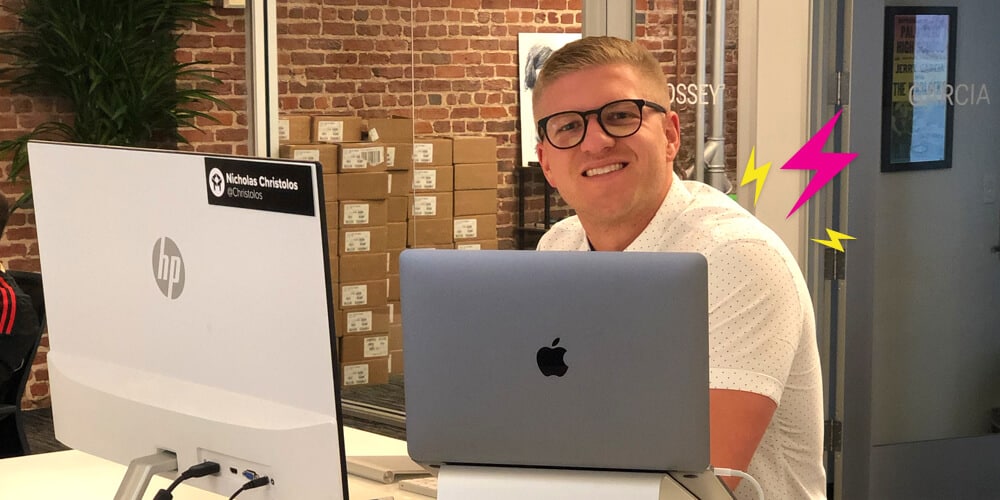
I used to be haunted by the disembodied voice of Alec Baldwin echoing around the office: “Always. Be. Closing.”
Talk to any sales rep and you know that the end of the quarter, or the end of the year, can be the most frantic time as everyone white-knuckles to the finish line of their quota. What if it didn’t have to be like that?
At the start of 2019, I set a BIG goal to hit my annual numbers before the end of the year.
A few days ago, I did just that.
I’ve learned a lot of hard lessons over the course of the last nine months – here’s how I went from zero to 100 percent of my quota a full three months early.
Optimize Your Time First
1. Shoot For The Moon
There’s an old episode of Seeking Wisdom that still gets me on this. As DC says, “You can’t aim and hit a target that you can’t see. That’s why it’s so important for us to set goals.”
The first way to hit your quota before the end of the year? Decide to.
Here’s what I do. I set what feels like a ridiculous goal so that even if I don’t actually hit it, I still end up achieving more. I try for around 125% of my monthly quota each month, so if I hit 110% or even 100%, I’m still in good shape. A lot of people think of their goal as static – but when you shoot for 100%, you may only end at 90%.
Why not see what you can challenge yourself to do?
Then, I track it obsessively. I have my own spreadsheet that tracks each month of the year, the quota for that month, what I ended up closing, and the percentage attainment. Then, I calculate the ARR/MRR I need to be able to hit 100%, 110%, 125%, and so on, so that I know what the literal number I need to sell each month to be able to hit my goal, not just my quota.
2. Treat Your Open Pipeline Every Single Day
It’s much easier to push your contacts already engaged and in the funnel over the finish line than constantly attracting new people.
Every day, I set aside 30 minutes to review my open pipeline report. I think through each deal and determine one action I can take that day and the next day to help move that deal forward.
One action per deal. Every day.
That one activity may not take a ton of time. It might be as simple as checking their LinkedIn and liking a recent post so I can stay top of mind or sharing a new blog post with them via email.

That half-hour of time spent on how I’m organizing my day keeps me from scrambling – and I always know what matters so I’m making steady progress on every deal, every day.
3. Spend More Time With Bigger Deals
Most sales reps are either base hitters – racking up smaller deals, but consistently – or they’re whale hunters – focusing only on the biggest bets. Me? I like to do both.
Once I know where each deal is in the pipeline, I can prioritize the ones that will make the most impact. That sounds obvious, but when the to-dos pile up from your pipeline, it can feel like you’re balancing a million plates at once. If you’ve planned out your day well (see #2), you’ll be able to easily see what you need to do to move all of your deals along, keeping your eye on the prize.
4. Trust Your Gut
I had a call just last week where I got on the phone for what I thought would be an initial call and I had a feeling they were further along in the process.
Just a feeling.
Normally on an initial call we keep it high level, but they were ready to talk about pricing and buying. When something like this happens, I take it and run with it. You should have a feeling right away where the person is and if they’re ready for the next step.
How to Talk to Your Prospects
5. Say My Name, Say My Name
Using names gives an immediate burst of familiarity and repetition. Let’s say I saw that Molly read a new post on the Drift blog, signed up for the email list, and has engaged with some content. I’ll send her a note – even if I’m not sure if she’s the buyer. But then I’ll also send another lead from the same company a note as a prospecting email.
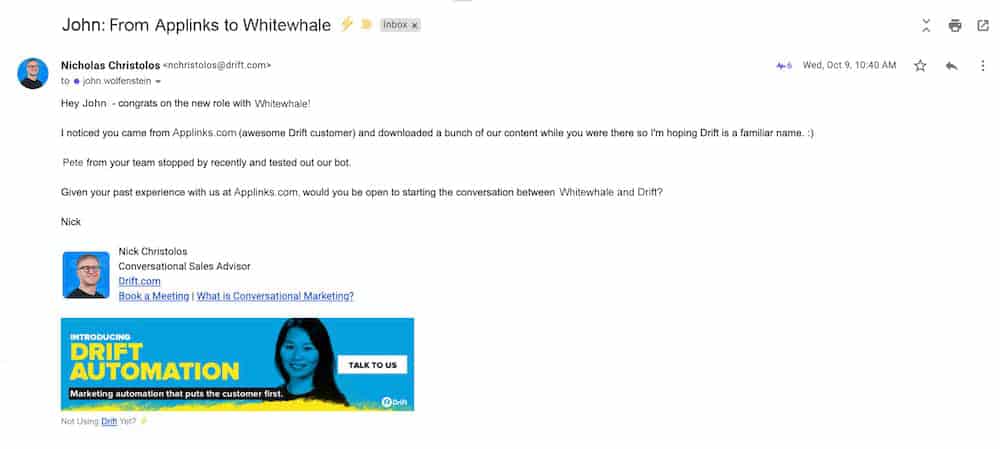
I usually keep it really simple and name-drop the colleague. Whenever people see familiar names in subject lines and emails, that significantly increases the open rate and reply rate.
6. Make the Most of Any Meeting
Once you’ve built that trust and booked the first meeting, it’s all about the prep work to be able to close faster. Here at Drift, we use a pre-call template that helps us learn more about a prospect. It looks something like this:
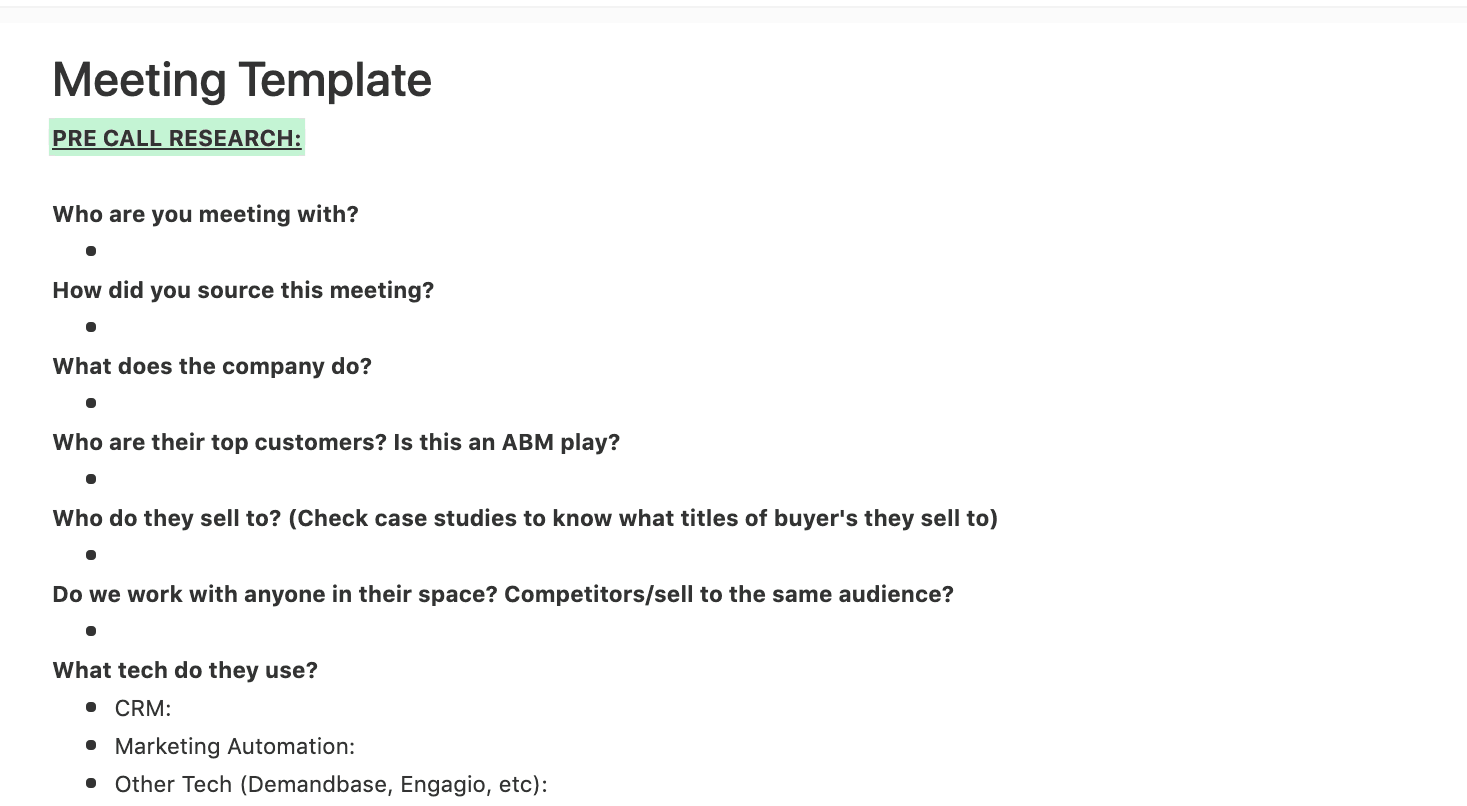
I used to send an email reminder the day before for our calls, but it never really worked. Instead of responses, I often got cancellations or asks for rescheduling.
Now, the day before, I send an email asking for more details so we have a more productive call. Here’s what it looks like:
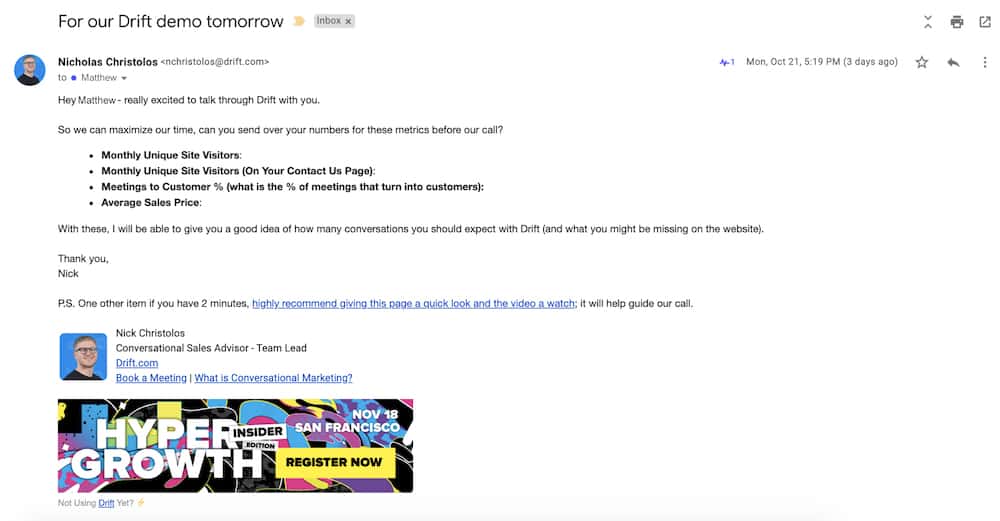
When we ask for things like lead goals and opportunity, we get nearly a 100% response rate. It gives prospects the time to look up the numbers, to think about the call, and it doesn’t get awkward or uncomfortable on the call.
They’ve got more skin in the game now – and more interest in what we can offer.
7. Make the Conversation About Them
I used to start my calls with, “What do you know about Drift?”
That never really went well.
It wouldn’t tell me what I needed to know – why they needed Drift in the first place. In that initial call, I need to find the pain point as soon as possible so that I can steer the conversation toward their goals, their priorities, and how we can help.
Now I start every call asking the prospect what it is they do every day so I can tailor the right features and benefits that actually solve the problem that matters most to them.
8. Create an Anchor with Reverse Timelining
Often I’ll use reverse timelining when I work with prospects who are further along in the sale because they don’t always realize what goes into setting up the product and getting it running. They expect to turn it on and have it immediately achieve their goals – but in reality, any product requires setup and optimization. It’s my job to light a fire under them so they commit to a purchase.
Let’s say I’m talking to a prospect that’s 1,000 leads short of their monthly goals. Here’s how a typical conversation would go:
- Me: With [Drift], here’s how you can reach your goal. How important is that to you?
- Them: Oh, really important. But we’re not going to be able to do that for three months.
- Me: Why is that?
- Them: Because of this, that, and the other thing.
- Me: When’s the very last point you would want Drift to go live?
- Them: Ideally, three months from now.
- Me: Well for that to happen, you’ll need to purchase within the next X days to make sure you’re set up in time for that date. Let’s get creative on payment terms, because if you want to hit that goal, you’ll need to purchase by X date.
I use their ultimate goal – the pain point that drove them to look for Drift in the first place – to create a sense of urgency so we can close faster.
Keep Deals Moving Forward
9. Use Texting
The best way I know a deal is moving along well? Texting. There’s only been one deal that I can think of this year that did not close that made it to the texting stage.
Texting is super personal, so it’s important not to abuse it.
It starts by getting their number. I usually keep it simple and just ask, “Hey, do mind if I give you a quick ring?” If they say yes, I’ll ask them for their cell phone number instead of setting up a video call. Then, right before the call, I’ll text them, “Hey, is this still a good time to chat?” It breaks down that barrier so that we can talk in real-time instead of over email.
10. Use Video
If there’s one thing every deal has in common, it’s that my prospects don’t have time to sit on a whole bunch of calls before making their decision. That’s where Drift Video has been huge for helping my deals along.
One way I’ve used video is to recap a call. After the first call, I’ll send a quick 3-5 minute recap video instead of a 45-minute recording so my prospect can share the information with the team.
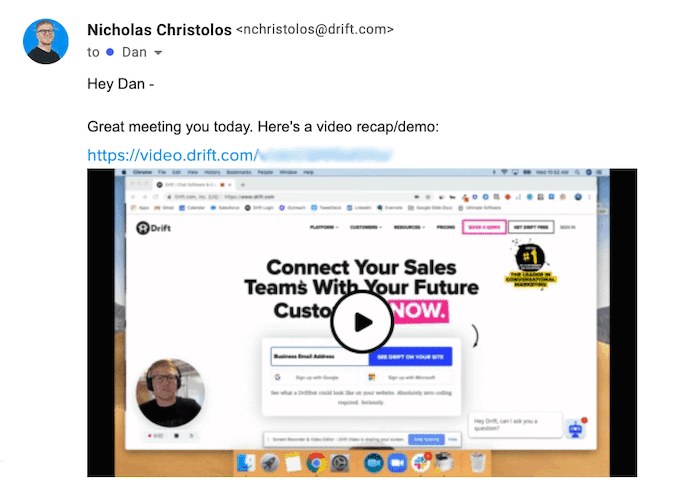
Then, I wait to see if anyone watches the video.
If it’s not, I’ll follow up and ask, “Hey, can you check out that video and let me know if it covers everything X person needs?” which gives me another chance to make sure our message is heard.
11. Use Swag
While I’m super focused on closing the deal, I know not every prospect is ready to purchase right now. The most important thing? Keeping that relationship solid long-term. When I can tell we’re not going to close, I’ll send them an email offering up some swag and asking for their address.

I have a really high response rate – it’s a little bit old school, but it goes a long way in maintaining the relationship. And even if they don’t wear it, it’s top of mind and our logo is hanging out in their office.
Forget “Always Be Closing.” Try, “Always Move Forward.”
Imagine my voice instead of Alec Baldwin’s. Yes, you should definitely always be closing. But think about it more like “Always Move Forward.” Every day, every activity I do helps me move a deal forward.
At the beginning of Q1, I had nothing but a hope that I would hit my goal – who knew I’d be writing a blog post on this? If I can do it, you can too.




